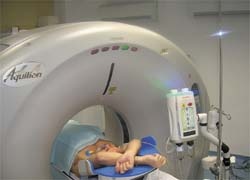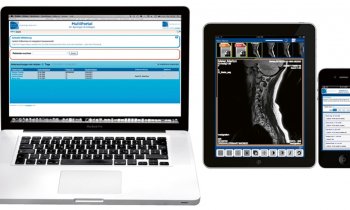Slovakia
Radiology in a small Central European country
Slovakia was part of the Austrian-Hungarian Empire until 1918, when Czechs and Slovaks were brought together to form the Czechoslovak Republic. After World War II, and up to 1948, the country was still part of Europe, but then fell behind the 'Iron Curtain'. From 1989 it began 'knocking on the EU door' and entry was granted in 2003. Today Slovakia's population is around 5.38 million. To serve that number, the country has 340 radiologists and 1,100 radiographers. Peter Bo×ruta MD PhD, Professor of Radiology and Head of Radiology at Slovak Medical University, in Bratislava, and Director of the Imaging Diagnostic Institute in Trnava, reports.

There are two famous Slovaks in the history of world radiology.
The Hungarian-German physicist Philipp Eduard Anton von Lénárd, (born: 1862, in Austria-Hungary – today Slovakia. Died: 1947 in Germany) won the Nobel Prize for Physics in 1905 for his research on cathode rays.
Vojtech Alexander, (born 1857 in Kezmarok, died 1916 in Budapest) founded radiology in the Kingdom of Hungary, and became one of the world’s most influential radiologists. Among his many achievements, he described the development of tuberculosis. He owned the first X-ray apparatus in Slovakia. He also wrote Slovak poems.
Behind the Iron Curtain
The history of Slovak radiology developed alongside Czech radiology in the Czechoslovak Republic. Training of Slovak radiologists in specialised X-ray centres in Prague and Hradec Kralove, and their close co-operation, improved the quality of X-ray centres in Slovakia’s state hospitals. Being in the east of Czechoslovakia, Slovakia has a slightly lower level due to having less equipment and personnel. From 1953, the government organised institutional post-graduate teaching for radiologists, radiographers and radiology technicians. Top quality radiology was centred in three towns, Bratislava (Slovakia’s capital city), Banska Bystrica (central Slovakia), Kosice (an eastern Slovakia metropolis). In 1983, the Biomedical Research institute in Bratislava had the first CT scanner in the country, and two more were installed within two years. The three radiology centres produced completely adequate X-ray diagnoses. Routine X-ray diagnoses were carried out at different quality levels in the state hospitals and external departments.
Czech, Slovak, Hungarian and East German radiology societies enjoyed close co-operation. Few of us had the opportunity to visit radiology departments and congresses in western countries. However, from time to time we had a chance to present our results abroad (ICR, ECR, national radiological congresses).
Knocking on the EU door (1989 – 1993)
After the political movement, changes in radiology in our country also took place. The splitting of the Czechoslovak Republic created a separate Slovak radiology society, with lots of work on own management. We had to prepare radiology guidelines for the government. Changes in medical care were followed by changes in radiology. Privatisation came as a new phenomenon to our medical care. We were under pressure to find the best way towards effective radiology. We had to choose the best from a lot of data. Former personal contacts helped us to implement data from many training programmes organised by EAR and University hospitals (Vienna, Graz, Zurich, Freiburg, Heidelberg and many others).
Into the EU (from 2003)
Improvements in politics and economic reforms accelerated growth in the amount of radiology equipment. There is continuous exchange of old X-ray apparatus by state-of-the-art apparatus, up to CR and DR. Old-fashioned axial CT scanners have been replaced by MSCT. We have two cardio MSCT, one 64 row and one 2x32 row detector CT. Today more than fifty CT scanners are in use. Among25 MRI units, we have nine open heart systems in private practice. We have six interventional X-ray centres.
Many of our X-ray departments have problems finding qualified radiologists. Lots of qualified personnel are leaving to find better paid jobs in EU countries. It is a very good indicator of our quality, but unfortunately brings us the serious problem of finding adequate substitutes.
In post graduate teaching we can accept some positive improvements and we add positive ideas from EU recommendations to our post graduate programmes.
Close co-operations with EAR, radiological societies of EU countries, and special teaching programmes (the Star programme organised by EAR, Schering, Siemens, SRS, SMU; the Hands-on Workshop organised by Heidelberg, EAR, Schering, SZU) are just a few teaching activities.
Attendance of the German-Slovak radiological association was also a step towards close co-operation to exchange data regarding radiological improvements, research, and teaching. To improve radiology, or standardise radiology in EU countries, visits by experts and the exchange of residents and students is a necessity.
The end result of close co-operation between radiologists at Heidelberg University, the private radiology group Linz and the radiology group in Slovakia, is the Imaging Diagnostic Institute in Trnava. The first fully equipped X-ray department with CR, body ultrasound, mammography, 64 MSCT, with cardio and MRI, has been operating for a year. They use RIS and PACS to be more effective and improve results. Top qualified personnel, state-of-the-art algorithm, and a high level of room configuration, guarantee the highest level of radiology examinations and postgraduate teaching programmes for radiologists and X-ray technicians.
Slovak radiology has a good chance of becoming a qualified member of EAR.
08.03.2007










